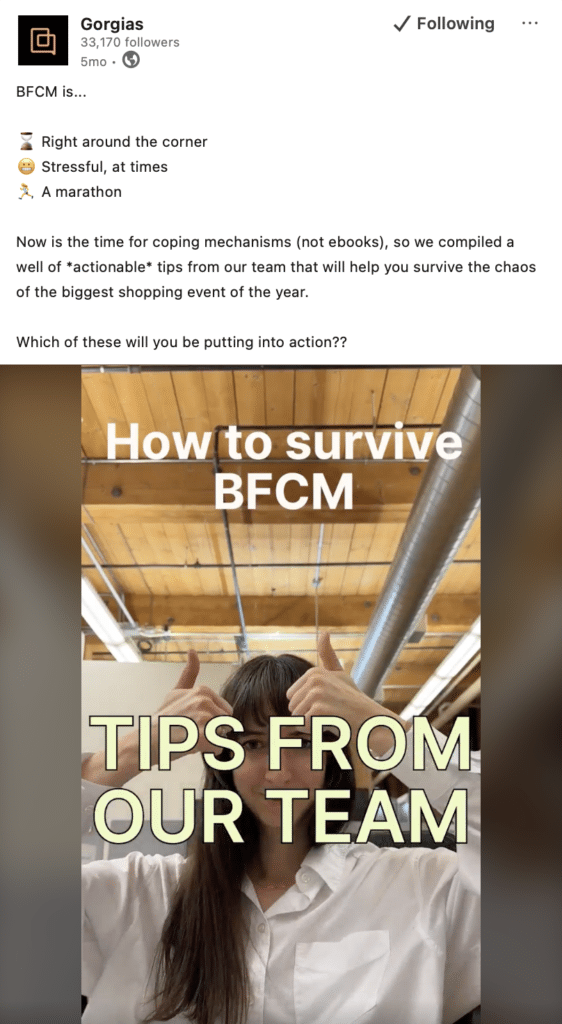Short-form B2B video marketing has quickly become a powerful tool for global brands. As platforms like TikTok, Instagram Reels and YouTube Shorts shape how content is consumed, forward-thinking B2B brands are using them to showcase expertise and connect with international audiences in a more authentic way.
Today’s decision-makers expect quick, relevant content that doesn’t feel like a sales pitch. When done right, short-form video builds credibility, drives engagement and makes your brand more relatable.
In this article, we’ll look at the strategies and platforms that matter most for short-form B2B video marketing so you can stay ahead and cut through the noise.
The rise of short-form B2B marketing video

Ever since TikTok hit the mainstream in 2020, short-form videos have become one of the primary methods of media consumption, with pretty much every social media platform trying to create its own short-form video app. From Instagram Reels to YouTube Shorts, short-form videos are everywhere. Marketers caught on pretty quickly, and in the past few years, B2B marketing has followed suit.
In a 2024 B2B marketing report, 75% of marketers said that social media was their most-used channel, and videos and infographics were the top kinds of content they were making for social. 65% of respondents said they were planning to increase their use of video.
Short-form videos in particular seemed to be performing well for B2B marketers. In the same report, they had the highest ROI (55%) of all types of B2B social marketing content produced. To compare, testimonials and case studies had an ROI of 44%, product demos 40%, and thought leader interviews 39%.
Short-form video’s popularity in marketing as a whole is driven by the fact that consumers and decision-makers mostly consume entertainment from their phones (75% of US adults spend up to two hours a day watching short-form videos). They have shorter attention spans, and have a lower tolerance for viewing content that’s clearly selling a product or service.
Paula Uccelli, a Project Manager at VeraContent, explains that short-form video’s popularity is increasing because businesses are starting to understand that short-form videos can be relevant for them, regardless of their industry.
According to Paula, “When TikTok and Reels first blew up, many companies were still hesitant to invest in video, because historically, videos were more expensive than graphic design or still photography, since you had to hire a production company, models and editors, and the turnaround times were pretty long.”
But now, Paula adds, having professional content creators who can make quality short videos for your company on a phone with a reasonable budget “changed the game.” Now that more companies are working with content creators and seeing results, they’re more open to them and their ideas. These creators know how to edit, tell the brand story, and speak to their audience.
While the medium is becoming more common, creating quality short-form video content can still set your brand apart and position it as an innovator in your industry. While creating video content is easier and cheaper than it’s ever been, it still requires more forethought and investment than a static Facebook ad. Plus, as these types of videos are more about personalities than information, they’re harder to replicate with AI tools.
Examples of global brands succeeding with short-form B2B video marketing

Many B2B businesses are successfully implementing short-form video. We want to spotlight a few that we think are doing a particularly great job:
1. B2B video marketing example: Monday.com
Monday.com, a cloud-based project management software platform, caters to businesses of all sizes across a variety of industries. For one of their B2B videos on TikTok, they enlisted an influencer named Janell Roberts to showcase their product in a “day in my life” video.
@janell.roberts ad | Being a CEO is not for the faint of heart, using @mondaydotcom helps me stay balanced as the first in my family to do it #mondaypartner #femaleentrepreneur #femalebusinessowner #dayinmylife
♬ original sound – Janell
In the advertorial-style video, Janell clearly shows how different monday.com features help make her life easier in a variety of different applications. The product showcase is woven easily into the video, and doesn’t feel forced.
2. B2B video marketing example: Shopify
Shopify, the massive e-commerce platform, shared this reel to Instagram that effectively and succinctly showcases its newly launched product features.
The video combines actual footage of how each product works with a voiceover to explain the benefits, so customers know exactly what they’re getting. While the video doesn’t have a CTA, it helps it not feel too salesy and still encourages current and new Shopify customers to check out the highlighted features.
3. B2B video marketing example: Gorgias
Gorgias, an AI-based sales and customer support platform, took a slightly different approach with this funny video they posted on LinkedIn during Black Friday/holiday sales season.
The video has almost no dialogue, but the actions and text on screen still effectively convey what they’re trying to say. The lack of CTA at the end shows empathy towards their likely overwhelmed audience, and it can attract potential employees, as it makes the office seem like a fun and supportive place to work.
4. B2B video marketing example: VeraContent
At VeraContent, we’ve also embraced the power of short-form video on our new TikTok channel. For example, we shared a behind-the-scenes “day in the life” video featuring one of our Project Managers. This type of content highlights our company culture and builds trust with potential clients by showing the real people behind our processes.
@veracontent A day in the life as a Project Management Intern at VeraContent: Project Management Workshop Edition. #project #projectmanagement #international #intern #content #trending #fyp #marketing #barcelona #madrid
♬ April (No Vocals) – The Young Ebenezers
We also repurpose clips from our podcast episodes into short-form videos, like this one where we talk about AI tools and their limitations.
@veracontent AI isn’t going to replace humans. Here’s why… #trending #ai #chatgpt #fyp
♬ Countless – Official Sound Studio
By condensing longer conversations into bite-sized, insight-driven clips, we’re able to share value quickly while driving traffic back to our full episodes. These videos give our audience quick takeaways while showcasing our team’s expertise in localization, content strategy and international marketing.
See also: Global social media marketing trends to watch in 2025
Why short-form video works for B2B marketing

Short-form B2B video marketing works for a variety of reasons:
- Getting people’s attention: Key decision-makers you want to target are probably saturated with information. Short-form videos allow you to hook the viewer and deliver your message in seconds, increasing the likelihood of awareness and lead conversion.
- Conveying complex information, simply: Short-form videos’ short length forces you to break down things like complex ideas, product features or industry news into quick, easy-to-digest hits of content. Your audience is more likely to both understand and retain what you’re telling them.
- Increasing engagement: Short-form videos tend to have higher completion rates than other types of content. Viewers will get your whole message and are more likely to remember it.
- Social sharing: Videos under 60 seconds are highly shareable. If a viewer finds a short-form video particularly memorable, they may share it in their story or even re-upload it to another platform. Compared to other types of content, short-form videos are more likely to get views outside your current network, increasing your visibility and potentially generating leads from segments you weren’t aware of.
- Boosting your SEO: You may have noticed recently that if you ask a question on Google, the first results on the page are often two or three short-form videos, from social platforms or even a company’s own website. Just like longer videos, your short videos are indexed by Google and can help you appear higher on search engine results pages. To make content that search engines love, make sure your videos have closed captions and/or a transcript.
- A new way of building trust: The more creative and free-form feel of short-form video can empower you to share more authentic content like behind-the-scenes clips, UGC, and thought leadership content. These fun and interesting videos can help your brand come off as more relatable and credible.
- Creating cost-effective content: While in the past, videos required a whole team of people and expensive cameras, the down-to-earth quality of short-form videos means that even small businesses can make engaging and successful videos with minimal resources.
See also: How to run an effective multilingual SEO campaign

Top platforms for short-form B2B video marketing

It seems like pretty much every social network has a short-form video component similar to TikTok these days. Depending on your industry and target audience, most all of them can be used in B2B marketing.
Paula explains that whichever platform you use and how you use it depends on what you want to reflect with your brand. She suggests that if your brand is something cool and trendy, like an agency looking for new clients or trying to reach a younger audience, it makes sense for you to try out some current trends on Instagram or TikTok. But if your business has an expensive product in a more formal industry with a long sales cycle, or your core value is something like quality or advanced technology, your short-form video content needs to showcase that, too.
“We had a B2B client who we did some event recap videos with for their LinkedIn. They wanted the videos to look spontaneous, but we still needed to convey the quality of their product. We had to have certain quality protocols, like no background noise, good lighting and sharp editing,” says Paula.
Here’s a breakdown of the major platforms and where you should focus your resources based on your needs:
1. LinkedIn
As a B2B business, you probably already have a strong LinkedIn presence. As the biggest professional social network, posting videos on LinkedIn allows you to target specific industries and people with relative ease. While most companies are already posting videos on the platform, in 2024 it launched a new short-form video feature similar to TikTok or Instagram, giving companies new ways to play with the format.
Traditionally, B2B businesses have been uploading videos in portrait, landscape and square dimensions. However, if you’re looking to prioritize the LinkedIn Shorts view, we recommend you upload in vertical to reduce dead space. Common types of B2B videos uploaded to LinkedIn include thought leadership content, professional insights, client success stories, podcasts and video from events or workshops.
Some users experimenting with LinkedIn Shorts, however, have been reporting better success with clips originally made for TikTok or Instagram that were cross-posted onto LinkedIn. Typically, these clips are more aesthetic or lifestyle-focused, but still tied to their work or industry. As the short-form video side of LinkedIn is still in its infancy, you may have more freedom to experiment and see what sticks.
2. YouTube Shorts
YouTube Shorts has quietly become one of the biggest short-form video platforms since it launched in 2020, and it works great for B2B marketing. “When you’re on YouTube, you’re more open to consuming educational content, so it may lend itself even better to B2B than other social media platforms like Instagram,” Paula suggested.
One of the biggest benefits of YouTube Shorts is it allows you to tap into YouTube’s massive 2.5 billion active user base. It’s actually the second-largest social media platform after Facebook.
YouTube Shorts appear on the YouTube homepage, show up (usually at the top) in search results and on the sidebar as suggested videos. Once you start watching a short, you’ll enter the TikTok-style algorithm-based short-form video page, where you can scroll to keep watching other videos. This makes Shorts very discoverable and helpful when you want to expand your reach.
Users’ use of Shorts has taken off in the last few years—they’re viewed over 70 billion times a day, as of 2024. This is a 40% increase from 2023 and a 133% increase from 2022. And users aren’t just watching Shorts, they’re engaging with them too—as of Q1 2024, the platform has the highest engagement rate of all social video platforms. One in three marketers incorporating Shorts into their marketing strategy experienced a 15-25% increase in web traffic, and 50% reported gaining new YouTube subscribers.
As the largest video-sharing company, YouTube offers many built-in creation tools for making Shorts, such as a multi-segment camera, music library, text overlays and filters. You can also create shorts from long-form videos you’ve already uploaded to your channel by singling out specific moments, and you can link directly to longer videos or your website with a prominent button at the bottom of a Short.
YouTube audiences are mostly looking for content that educates or entertains, and the type of content you post to Shorts should reflect that. While many people do post hyper-trendy content, because YouTube works so well for evergreen discovery, it’s a good idea to upload content that breaks down important ideas relating to your business or product.
3. Instagram Reels
If you already have a well-performing presence on Instagram, it may be worth posting Reels to relate to your audience and expand your platform. While you may think of it as a bit informal, you can drive awareness and connect with potential clients and employees through videos that feature company culture and engage storytelling.
Videos that perform well on IG Reels include:
- A behind-the-scenes tour of a department
- Meeting and getting to know a specific team, either “casually” walking up to them mid-task and asking questions or “day in the life” glimpses of specific team members
- A before-and-after video comparing photos and videos from your company’s founding to how it’s doing now—don’t forget to focus on team members’ lives, too, not just the company
- Motivational clips from team members speaking at conferences or events
- FAQs showcasing your team’s insights and expertise
As Instagram is a visual-first platform and has been known for years for its focus on aesthetically pleasing content, make sure your videos posted here are high-quality and visually-appealing and maintain a cohesive aesthetic that works for your brand. Don’t forget to add captions and tag relevant people, as these increase your visibility on the explore page.
4. TikTok
Probably the first name you think of when you think of short-form video, TikTok can be a powerful tool if you’re targeting younger clients. Many small businesses are active TikTok users, and the famous algorithm can push your video out to a much wider audience than just your followers.
TikTok’s challenge for B2B marketers is that it requires a decent amount of investment. Unlike other social platforms, where short-form video is just a part of your content strategy, TikTok requires you to build a community entirely based on video content. Even though videos don’t have to be as polished on here as on other platforms, it’s still a big task for a B2B company without a robust video strategy.
Videos that perform well on TikTok are usually intriguing, funny or surprising. Using trending audios can help you be discovered more easily, but be careful with audios that already have millions and millions of views—your videos may just become white noise. You should also engage with commenters and other creators to help build a community without having to post a new video.
Many companies use TikTok to position themselves as industry experts and build credibility. By demonstrating understanding of the platform and relevant topics, you can attract potential clients who recognize your knowledge and see you as a trusted resource.
See also: Launching on TikTok: Strategies, trends and tips for brands
5. Facebook Reels
If your target audience is heavily on Facebook, it may be worth posting Facebook Reels. As you may expect, Facebook Reels have an older demographic, but content here may perform well depending on your audience.
7 Steps to crafting effective short-form videos for B2B

1. Know your audience
Like with any marketing campaign, it’s important to understand your audience when crafting your short-form B2B video marketing strategy. What platforms are already working well for you? Are there platforms you haven’t tapped into yet where your audience spends time?
For B2B video marketing specifically, identify common pain points within your industry or product and any insights or information your target audience would want to know.
See also: TikTok marketing strategy: Should you go global or local?
2. Choose your content
We mentioned most of these types of content before, but let’s expand a bit on the most common types of B2B short-form content and how you can implement them:
- Behind-the-scenes clips: We mentioned some examples before, but you can give your audience a glimpse at things like your company culture, personal insights about your team, and work processes with videos like “a day in the life at the office” or highlights from internal company events.
- Event highlights: If you’re attending or hosting an event like a conference or meet-up, share any highlights, insights or takeaways from your experience.
- Product demos and tutorials: Highlight key benefits or features of your product through quick demos, tutorials or tips. Keep it engaging and snappy to get potential customers interested.
- Educational content: Sharing information about your company or offering insights into your industry and current trends, you can build credibility with your audience. With thought leadership content in particular, we recommend working with relevant or high-ranking people in your business to make the videos more trustworthy. For example, get your CEO to talk about a recent market development or a software engineer to discuss current technology trends.
- Customer testimonials or case studies: You can work with satisfied clients to record and share quick, authentic and positive reviews of your work. You can also summarize previous successful projects to prove to your viewers that you’re a company worth working with.
- Repurposed content: Don’t be afraid to rework content you already have. If you already have a library of webinars, podcasts or blog posts, you can clip key moments from them or rework the content into video form.
3. Promote across channels
You don’t just have to upload your short-form videos onto one social media channel. You can upload the same or slightly modified videos to different short-form video platforms, or integrate them into your newsletters or website.
It goes the other way around, too. Pair your short-form videos with links to landing pages, downloadable resources like whitepapers or worksheets, or blog posts. This can help drive engagement to your other content and paint a clearer picture of how your short-form videos are driving engagement down the funnel.
4. Follow video standards
No matter the type of content you’re posting, there are some guidelines you should follow to make sure your content is engaging and share-worthy:
- Hook your audience right away. As soon as the video starts, you need to have a catchphrase or other tactic (like a question, pain point or statistic) to reel in viewers. This needs to be both spoken and written on screen, as many people watch videos without sound.
- Keep your delivery short, snappy and down to earth. Don’t spend valuable seconds saying a bunch of buzzwords or jargon that don’t convey any information. Delivery that’s too over the top and excitable can also be annoying for viewers.
- Implement visual elements and sound. You can use infographics when talking about a current trend, or upbeat music to set the mood for an exciting announcement. These can help hold viewers’ attention, but it’s important not to go overboard.
- Short-form videos should be in vertical format. All social video platforms are optimized for vertical viewing, so posting horizontal videos doesn’t look good, especially when everyone else is posting vertical content.
- Captions are always, always, necessary. Since so many people watch videos without sound (as high as 75%), posting a video without captions means alienating a large swath of viewers. Plus, having captions helps with SEO, as Google and other search engines will have an easier time cataloging your video.
- Don’t leave your viewers hanging at the end of a video. Implement a strong CTA with a clear action to take and why.
See also: TikTok translation: Auto-generated or the human touch?
5. Make an effective caption
Your caption’s content and length can vary depending on what platform you’re posting to. “On Facebook or LinkedIn, if I just see a video with no text, I think it’s a little bit weird, whereas on Instagram or TikTok, standalone videos feel more natural,” Paula explains.
However, some context is crucial for video engagement, as people often rely on the first line of text in conjunction with the video itself to understand the video’s purpose. While the key message should primarily be in the video, the caption should contain an easily digestible version of your message.
“Producing a video will cost you more than producing a caption. If you’re already producing the video and spending the money, you should make the caption great, with a clear and digestible message.”
6. Use employee-generated content (EGC)
As we said before, short-form videos are often personality-driven. In B2B video marketing, this has meant the rise of employee-generated content (EGC). Getting employees—who are comfortable in front of the camera, of course—to offer a candid, personal and authentic perspective of your brand can help bridge the gap between your brand and your audience and create more genuine connections.
“When you let your employees talk, you’re also showing that you’re a good place to work as well as your company values, even if it’s a funny video,” Paula said.
7. Measure and optimize
Like other marketing campaigns, you need to measure ROI and success to see what’s working and what’s not. Key metrics for short-form content include views, engagement, click-through rate, and conversions. Most short-form video apps will have tools that help you track things like views and engagement, but metrics like clicks and conversions may require other analytics programs.
It’s important to remember that not every video will be a success, no matter what kind of content you make or how well it’s made. The important thing is to analyze your content and see what’s performing well. This way, you can optimize things like length, topic and tone based on what your audience has responded well to.
If you’d like help creating short-form video content for your brand’s global social media channels, book a free call with our team today. We’d love to chat!



